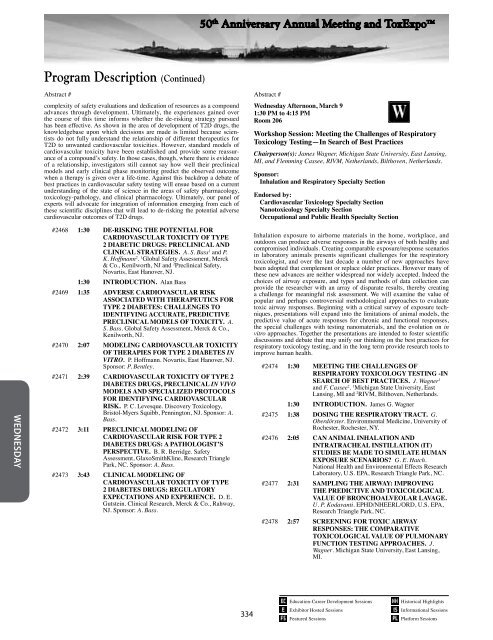Program - Society of Toxicology
Program - Society of Toxicology
Program - Society of Toxicology
You also want an ePaper? Increase the reach of your titles
YUMPU automatically turns print PDFs into web optimized ePapers that Google loves.
50 th Anniversary Annual Meeting and ToxExpo<br />
<strong>Program</strong> Description (Continued)<br />
Abstract # Abstract #<br />
complexity <strong>of</strong> safety evaluations and dedication <strong>of</strong> resources as a compound<br />
advances through development. Ultimately, the experiences gained over<br />
the course <strong>of</strong> this time informs whether the de-risking strategy pursued<br />
has been effective. As shown in the area <strong>of</strong> development <strong>of</strong> T2D drugs, the<br />
knowledgebase upon which decisions are made is limited because scientists<br />
do not fully understand the relationship <strong>of</strong> different therapeutics for<br />
T2D to unwanted cardiovascular toxicities. However, standard models <strong>of</strong><br />
cardiovascular toxicity have been established and provide some reassurance<br />
<strong>of</strong> a compound’s safety. In those cases, though, where there is evidence<br />
<strong>of</strong> a relationship, investigators still cannot say how well their preclinical<br />
models and early clinical phase monitoring predict the observed outcome<br />
when a therapy is given over a life-time. Against this backdrop a debate <strong>of</strong><br />
best practices in cardiovascular safety testing will ensue based on a current<br />
understanding <strong>of</strong> the state <strong>of</strong> science in the areas <strong>of</strong> safety pharmacology,<br />
toxicology-pathology, and clinical pharmacology. Ultimately, our panel <strong>of</strong><br />
experts will advocate for integration <strong>of</strong> information emerging from each <strong>of</strong><br />
these scientific disciplines that will lead to de-risking the potential adverse<br />
cardiovascular outcomes <strong>of</strong> T2D drugs.<br />
Wednesday Afternoon, March 9<br />
1:30 PM to 4:15 PM<br />
Room 206<br />
Workshop Session: Meeting the Challenges <strong>of</strong> Respiratory<br />
<strong>Toxicology</strong> Testing—In Search <strong>of</strong> Best Practices<br />
Chairperson(s): James Wagner, Michigan State University, East Lansing,<br />
MI, and Flemming Cassee, RIVM, Netherlands, Bilthoven, Netherlands.<br />
Sponsor:<br />
Inhalation and Respiratory Specialty Section<br />
Endorsed by:<br />
Cardiovascular <strong>Toxicology</strong> Specialty Section<br />
Nanotoxicology Specialty Section<br />
Occupational and Public Health Specialty Section<br />
Wednesday<br />
#2468 1:30 DE-RISKING THE POTENTIAL FOR<br />
CARDIOVASCULAR TOXICITY OF TYPE<br />
2 DIABETIC DRUGS: PRECLINICAL AND<br />
CLINICAL STRATEGIES. A. S. Bass 1 and P.<br />
K. H<strong>of</strong>fmann 2 . 1 Global Safety Assessment, Merck<br />
& Co., Kenilworth, NJ and 2 Preclinical Safety,<br />
Novartis, East Hanover, NJ.<br />
1:30 INTRODUCTION. Alan Bass<br />
#2469 1:35 ADVERSE CARDIOVASCULAR RISK<br />
ASSOCIATED WITH THERAPEUTICS FOR<br />
TYPE 2 DIABETES: CHALLENGES TO<br />
IDENTIFYING ACCURATE, PREDICTIVE<br />
PRECLINICAL MODELS OF TOXICITY. A.<br />
S. Bass. Global Safety Assessment, Merck & Co.,<br />
Kenilworth, NJ.<br />
#2470 2:07 MODELING CARDIOVASCULAR TOXICITY<br />
OF THERAPIES FOR TYPE 2 DIABETES IN<br />
VITRO. P. H<strong>of</strong>fmann. Novartis, East Hanover, NJ.<br />
Sponsor: P. Bentley.<br />
#2471 2:39 CARDIOVASCULAR TOXICITY OF TYPE 2<br />
DIABETES DRUGS, PRECLINICAL IN VIVO<br />
MODELS AND SPECIALIZED PROTOCOLS<br />
FOR IDENTIFYING CARDIOVASCULAR<br />
RISK. P. C. Levesque. Discovery <strong>Toxicology</strong>,<br />
Bristol-Myers Squibb, Pennington, NJ. Sponsor: A.<br />
Bass.<br />
#2472 3:11 PRECLINICAL MODELING OF<br />
CARDIOVASCULAR RISK FOR TYPE 2<br />
DIABETES DRUGS: A PATHOLOGIST’S<br />
PERSPECTIVE. B. R. Berridge. Safety<br />
Assessment, GlaxoSmithKline, Research Triangle<br />
Park, NC. Sponsor: A. Bass.<br />
#2473 3:43 CLINICAL MODELING OF<br />
CARDIOVASCULAR TOXICITY OF TYPE<br />
2 DIABETES DRUGS: REGULATORY<br />
EXPECTATIONS AND EXPERIENCE. D. E.<br />
Gutstein. Clinical Research, Merck & Co., Rahway,<br />
NJ. Sponsor: A. Bass.<br />
Inhalation exposure to airborne materials in the home, workplace, and<br />
outdoors can produce adverse responses in the airways <strong>of</strong> both healthy and<br />
compromised individuals. Creating comparable exposure/response scenarios<br />
in laboratory animals presents significant challenges for the respiratory<br />
toxicologist, and over the last decade a number <strong>of</strong> new approaches have<br />
been adopted that complement or replace older practices. However many <strong>of</strong><br />
these new advances are neither widespread nor widely accepted. Indeed the<br />
choices <strong>of</strong> airway exposure, and types and methods <strong>of</strong> data collection can<br />
provide the researcher with an array <strong>of</strong> disparate results, thereby creating<br />
a challenge for meaningful risk assessment. We will examine the value <strong>of</strong><br />
popular and perhaps controversial methodological approaches to evaluate<br />
toxic airway responses. Beginning with a critical survey <strong>of</strong> exposure techniques,<br />
presentations will expand into the limitations <strong>of</strong> animal models, the<br />
predictive value <strong>of</strong> acute responses for chronic and functional responses,<br />
the special challenges with testing nanomaterials, and the evolution on in<br />
vitro approaches. Together the presentations are intended to foster scientific<br />
discussions and debate that may unify our thinking on the best practices for<br />
respiratory toxicology testing, and in the long term provide research tools to<br />
improve human health.<br />
#2474 1:30 MEETING THE CHALLENGES OF<br />
RESPIRATORY TOXICOLOGY TESTING -IN<br />
SEARCH OF BEST PRACTICES. J. Wagner 1<br />
and F. Cassee 2 . 1 Michigan State University, East<br />
Lansing, MI and 2 RIVM, Bilthoven, Netherlands.<br />
1:30 INTRODUCTION. James G. Wagner<br />
#2475 1:38 DOSING THE RESPIRATORY TRACT. G.<br />
Oberdörster. Environmental Medicine, University <strong>of</strong><br />
Rochester, Rochester, NY.<br />
#2476 2:05 CAN ANIMAL INHALATION AND<br />
INTRATRACHEAL INSTILLATION (IT)<br />
STUDIES BE MADE TO SIMULATE HUMAN<br />
EXPOSURE SCENARIOS? G. E. Hatch.<br />
National Health and Environmental Effects Research<br />
Laboratory, U.S. EPA, Research Triangle Park, NC.<br />
#2477 2:31 SAMPLING THE AIRWAY: IMPROVING<br />
THE PREDICTIVE AND TOXICOLOGICAL<br />
VALUE OF BRONCHOALVEOLAR LAVAGE. <br />
U. P. Kodavanti. EPHD/NHEERL/ORD, U.S. EPA,<br />
Research Triangle Park, NC.<br />
#2478 2:57 SCREENING FOR TOXIC AIRWAY<br />
RESPONSES: THE COMPARATIVE<br />
TOXICOLOGICAL VALUE OF PULMONARY<br />
FUNCTION TESTING APPROACHES. J.<br />
Wagner. Michigan State University, East Lansing,<br />
MI.<br />
334<br />
Education-Career Development Sessions<br />
Exhibitor Hosted Sessions<br />
Featured Sessions<br />
Historical Highlights<br />
Informational Sessions<br />
Platform Sessions
















